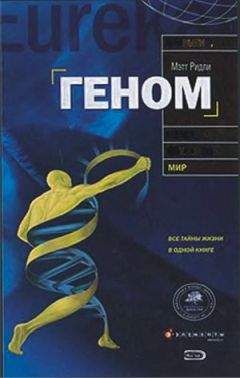Мэтт Ридли - Геном: автобиография вида в 23 главах
Lefebvre L. et al. 1998. Abnormal maternal behaviour and growth retardation associated with loss of the imprinted gene Mest. Nature Genetics 20: 163–169.
158
Pagel M. 1999. Mother and father in surprise genetic agreement. Nature 397: 19–20.
159
Skuse D. H. et al. 1997. Evidence from Turner’s syndrome of an imprinted locus affecting cognitive function. Nature 397: 19–20.
160
Diamond M., Sigmundson H. K. 1997. Sex assignment at birth: long-term review and clinical implications. Archives of Pediatric and Adolescent Medicine 151: 298–304.
161
Baldwin J. M. 1896. A new factor in evolution. American Naturalist 30: 441–451.
162
Schacher S. et al. 1988. cAMP evokes long-term facilitation in Aplysia neurons that requires new protein synthesis. Science 240: 1667–1669.
163
Bailey C. H., Bartsch D., Kandel E. R. 1996. Towards a molecular definition of long-term memory storage. Proceedings of the National Academy of Science of the USA 93: 12445–12452.
164
Tully T. et al. 1994. Genetic dissection of consolidated memory in Drosophila. Cell 79: 39–47;
Dubnau J., Tully T. 1998. Genetic discovery in Drosophila: new insights for learning and memory. Annual Review of Neuroscience 21: 407–444.
165
Silva A. J., Smith A. M., Giese K. P. 1997. Gene targeting and the biology of learning and memory. Annual Review of Genetics 31: 527–546.
166
Davis R. L. 1993. Mushroom bodies and Drosophila learning. Neuron 11: 1–14;
Grotewiel M. S. et al. 1998. Integrin-mediated short-term memory in Drosophila. Nature 391: 455–460.
167
Vargha-Khadem F. et al. 1997. Differential effects of early hippocampal pathology on episodic and semantic memory. Science 277: 376–380.
168
Hakem R. et al. 1998. Differential requirement for caspase 9 in apoptotic pathways in vivo. Cell 94: 339–352.
169
Ridley M. 1996. The origin of virtue. Viking, London;
Raff M. 1998. Cell suicide for beginners. Nature 396: 119–122.
170
Cookson W. 1994. The gene hunters: adventures in the genome jungle. Aurum Press, London.
171
Robert Weinberg 1998. One renegade cell. Weidenfeld and Nicolson, London.
172
Levine A. J. 1997. p53, the cellular gatekeeper for growth and division. Cell 88: 323–331.
173
Lowe S. W. 1995. Cancer therapy and p53. Current Opinion in Oncology 7: 547–553.
174
Hüber A.-O., Evan G. I. 1998. Traps to catch unwary oncogenes. Trends in Genetics 14: 364–367.
175
Cook-Deegan R. 1994. The gene wars: science, politics and the human genome. W. W. Norton, New York.
176
Krakauer D. C., Payne R. J. 1997. The evolution of virus-induced apoptosis. Proceedings of the Royal Society of London, Series B 264: 1757–1762.
177
Verma I. M., Somia N. 1997. Gene therapy — promises, problems and prospects. Nature 389: 239–242.
178
Capecchi M. R. 1989. Altering the genome by homologous recombination. Science 244: 1288–1292.
179
First N., Thomson J. 1998. From cows stem therapies? Nature Biotechnology 16: 620–621.
180
Lyon J., Corner P. 1996. Altered fates. Norton, New York.
181
Eto M., Watanabe K., Makino I. 1989. Increased frequencies of apolipoprotein E2 and E4 alleles in patients with ischemic heart disease. Clinical Genetics 36: 183–188.
182
Lucotte G., Loirat F., Hazout S. 1997. Pattern of gradient of apolipoprotein E allele *4 frequencies in western Europe. Human Biology 69: 253–262.
183
Kamboh M. I. 1995. Apolipoprotein E polymorphism and susceptibility to Alzheimer’s disease. Human Biology 67: 195–215;
Flannery T. 1998. Throwing way leg. Weidenfeld and Nicolson, London.
184
Cook-Degan R. 1995. The gene wars, politics and the human genome. Norton, New York.
185
Kamboh M. I. 1995. Apolipoprotein E polymorphism and susceptibility to Alzheimer’s disease. Human Biology 67: 195–215;
Corder E. H. et al. 1994. Protective effect of apoipoprotein E type 2 allele for late onset Alzheimer disease. Nature Genetics 7: 180–184.
186
Bickeboller H. et al. Apolipoprotein E and Alzheimer disease: genotypic-specific risks by age and sex. American Journal of Human Genetics 60: 439–446;
Payami H. et al. 1996. Gender difference in apolipoprotein E-associated risk for familial Alzheimer disease: a possible clue to the higher incidence of Alzheimer disease in women. American Journal of Human Genetics 58: 803–811;
Tang M. X. et al. 1996. Relative risk of Alzheimer disease and age-at-onset distributions, based on APOE genotypes among elderly African Americans, Caucasians, and Hispanics in New York City. American Journal of Human Genetics 58: 574–584.
187
Caldicott F. et al. 1998. Mental disorders and genetics: the ethical context. Nuffield Council on Bioethics, London.
188
Maddox J. 1998. What remains to be discovered? Macmillan, London.
189
Cookson C. 1998. Markers on the road to avoiding illness. Financial Times, 3 March 1998, p. 18;
Schmidt K. 1998. Just for you. New Scientist, 14 November 1998, p. 32.
190
Wilkie T. 1996. The people who want to look inside your genes. Guardian, 3 October 1996.
191
Prusiner S. B., Scott M. R. 1997. Genetics of prions. Annual Review of Genetics 31: 139–175.
192
Brown D. R. et al. 1997. The cellular prion protein binds copper in vivo. Nature 390: 684–687.
193
Prusiner S. B. et al. 1998. Prion protein biology. Cell 93: 337–349.
194
Klein M. A. et al. 1997. A crucial role for В cells in neuroinvasive scrapie. Nature 390: 687–690.
195
Ridley R. M., Baker H. F. 1998. Fatal protein. Oxford University Press, Oxford.
196
Hawkins M. 1997. Social Darwinism in European and American Thought, 1860–1945. Cambridge University Press, Cambridge.
197
Kevles D. 1985. In the name of eugenics. Harvard University Press, Cambridge, Massachusetts.
198
Paul D. B., Spencer H. G. 1995. The hidden science of eugenics. Nature 374: 302–305.
199
Carey J. 1992. The intellectuals and the masses. Faber and Faber, London.
200
Anderson G. 1994. The politics of the 1913 mental deficiency act. M.Phil dissertation, University of Cambridge.
201
Wells H. G. et al. 1931. The science of life. Cassell, London.
202
Lindzen R. 1996. Science and politics: global warming and eugenics. In: Hahn R. W. (ed.), Risks, costs and lives saved, p. 85–103. Oxford University Press, Oxford.
203
King D., Hansen R. 1999. Experts at work: state autonomy, social learning and eugenic sterilisation in 1930s Britain. British Journal of Political Science 29: 77–107.
204
Searle G. R. 1979. Eugenics and politics in Britain in the 1930s. Annals of Political Science 36: 159–169.
205
Kitcher P. 1996. The lives to come. Simon and Shuster, New York.
206
Lynn R. 1996. Dysgenics: genetic deterioration in modern populations. Praeger, Westport, Connecticut.
207
Morton N. 1998. Hippocratic or hypocritic: Birth pangs of an ethical code. Nature Genetics 18:18;
Coghlan A. 1998. Perfect people’s republic. New Scientist, 24 October 1998, p. 24.
208
Rich Harris J. 1998. The nurture assumption. Bloomsbury, London.
209
Rich Harris J. 1998. The nurture assumption. Bloomsbury, London.
210
Rich Harris J. 1998. The nurture assumption. Bloomsbury, London.
211
Ehrenreich B., McIntosh J. 1997. The new creationism. Nation, 9 June 1997.
212
Reznek L. 1997. Evil or ill? Justifying the insanity defence. Routledge, London.
213
Wright R. 1994. The moral animal. Pantheon, New York.
214
Silver B. 1998. The ascent of science. Oxford University Press, Oxford.
215
Ayer A. J. 1954. Philosophical essays. Macmillan, London.
216
Цитата из Wright L. 1997. Twins: genes, environment, and the mystery of identity. Weidenfeld and Nicolson, London.




